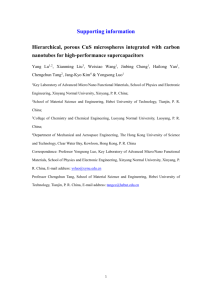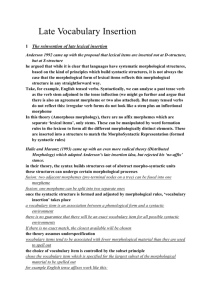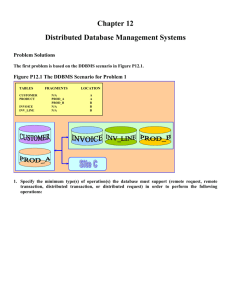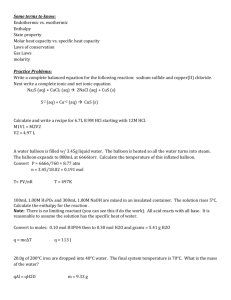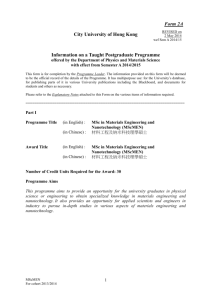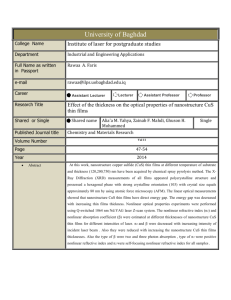chp12
advertisement
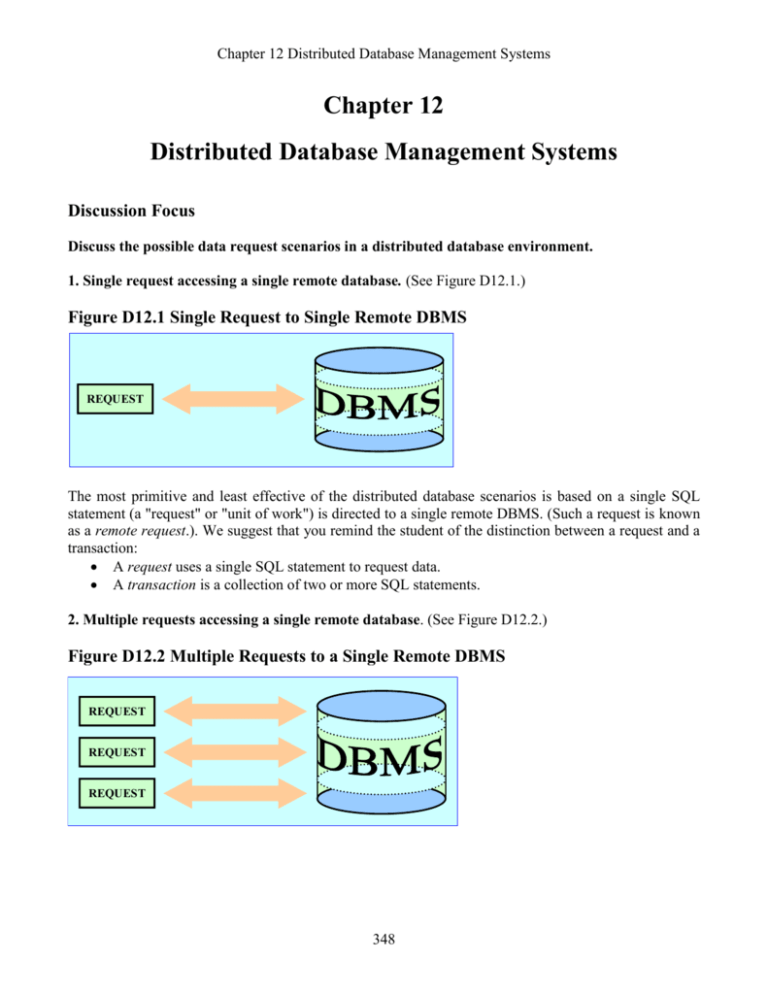
Chapter 12 Distributed Database Management Systems
Chapter 12
Distributed Database Management Systems
Discussion Focus
Discuss the possible data request scenarios in a distributed database environment.
1. Single request accessing a single remote database. (See Figure D12.1.)
Figure D12.1 Single Request to Single Remote DBMS
REQUEST
The most primitive and least effective of the distributed database scenarios is based on a single SQL
statement (a "request" or "unit of work") is directed to a single remote DBMS. (Such a request is known
as a remote request.). We suggest that you remind the student of the distinction between a request and a
transaction:
A request uses a single SQL statement to request data.
A transaction is a collection of two or more SQL statements.
2. Multiple requests accessing a single remote database. (See Figure D12.2.)
Figure D12.2 Multiple Requests to a Single Remote DBMS
REQUEST
REQUEST
REQUEST
348
Chapter 12 Distributed Database Management Systems
A unit of work now consists of multiple SQL statements directed to a single remote DBMS. The local
user defines the start/stop sequence of the units of work, using COMMIT, but the remote DBMS
manages the unit of work's processing.
3. Multiple requests accessing multiple remote databases. (See Figure D12.3.)
Figure D12.3 Multiple requests, Multiple Remote DBMSes
REQUEST
REQUEST
REQUEST
REQUEST
REQUEST
A unit of work now may be composed of multiple SQL statements directed to multiple remote DBMSes.
However, any one SQL statement may access only one of the remote DBMSes. As was true in the
second scenario, the local user defines the start/stop sequence of the units of work, using COMMIT, but
the remote DBMS to which the SQL statement was directed manages the unit of work's processing. In
this scenario, a two-phase COMMIT must be used to coordinate COMMIT processing for the multiple
locations.
349
Chapter 12 Distributed Database Management Systems
4. Multiple requests accessing any combination of multiple remote DBMSes. (See Figure D12.4.)
Figure D12.4 Multiple Requests and any Combination of Remote Databases
REQUEST
REQUEST
REQUEST
A unit of work now may consist of multiple SQL statements addressed to multiple remote DBMSes, and
each SQL statement may address any combination of databases. As was true in the third scenario, each
local user defines the start/stop sequence of the units of work, using COMMIT, but the remote DBMS to
which the SQL statement was directed manages the unit of work's processing. A two-phase COMMIT
must be used to coordinate COMMIT processing for the multiple locations.
Remaining discussion focus:
The review questions cover a wide range of distributed database concept and design issues. The most
important questions to be raised are:
What is the difference between a distributed database and distributed processing?
What is a fully distributed database management system?
Why is there a need for a two-phase commit protocol, and what are these two phases?
What does "data fragmentation" mean, and what strategies are available to deal with data
fragmentation?
Why and how must data replication be addressed in a distributed database environment? What
replication strategies are available, and how do they work?
Since the current literature abounds with references to file servers and client-server architectures,
what do these terms mean? How are file servers different from client/server architectures? Why
would you want to know?
350
Chapter 12 Distributed Database Management Systems
We have answered these questions in detail in the Answers to Review Question section of this chapter.
Note particularly the answers to questions 5, 6, 11, and 15-17.
NOTE
Many questions raised in this section are more specific -- and certainly more technical -- than
the questions raised in the previous chapters. Since the chapter covers the answers to these
questions in great detail, we have elected to give you section references to avoid needless
duplication.
Answers to Review Questions
1. Describe the evolution from centralized DBMSs to distributed DBMSs.
This question is answered in detail in section 12.1.
2. List and discuss some of the factors that influenced the evolution of the DDBMS.
These factors are listed and discussed in section 12.1.
3. What are the advantages of the DDBMS?
See section 12.1.1.
4. What are the disadvantages of the DDBMS?
See section 12.1.2.
5. Explain the difference between distributed database and distributed processing.
See section 12.2.
6. What is a fully distributed database management system?
See section 12.3.
7. What are the components of a DDBMS?
See section 12.4.
8. List and explain the transparency features of a DDBMS.
See section 12.6.
351
Chapter 12 Distributed Database Management Systems
9. Define and explain the different types of distribution transparency.
See section 12.7.
10. Describe the different types of database requests and transactions.
A database transaction is formed by one or more database requests. Each database request is the
equivalent of a single SQL statement. The basic difference between a local transaction and a
distributed transaction is that the latter can update or request data from several remote sites on a
network. In a DDBMS, a database request and a database transaction can be of two types: remote or
distributed.
NOTE
The figure references in the discussions refer to the figures found in the text.
Note: The figure references in the discussions refer to the figures found in the text. The figures are
not reproduced in this manual.
A remote request accesses data located at a single remote database processor (or DP site). In other
words, an SQL statement (or request) can reference data at only one remote DP site. Use Figure
12.10 to illustrate the remote request.
A remote transaction, composed of several requests, accesses data at only a single remote DP site.
Use Figure 12.11 to illustrate the remote transaction.
As you discuss Figure 12.11, note that both tables are located at a remote DP (site B) and that the
complete transaction can reference only one remote DP. Each SQL statement (or request) can
reference only one (the same) remote DP at a time; the entire transaction can reference only one
remote DP; and it is executed at only one remote DP.
A distributed transaction allows a transaction to reference several different local or remote DP sites.
Although each single request can reference only one local or remote DP site, the complete
transaction can reference multiple DP sites because each request can reference a different site. Use
Figure 12.12 to illustrate the distributed transaction.
A distributed request lets us reference data from several different DP sites. Since each request can
access data from more than one DP site, a transaction can access several DP sites. The ability to
execute a distributed request requires fully distributed database processing because we must be able
to:
1. Partition a database table into several fragments.
2. Reference one or more of those fragments with only one request. In other words, we must
have fragmentation transparency.
352
Chapter 12 Distributed Database Management Systems
The location and partition of the data should be transparent to the end user. Use Figure 12.13 to
illustrate the distributed request.
As you discuss Figure 12.13, note that the transaction uses a single SELECT statement to reference
two tables, CUSTOMER and INVOICE. The two tables are located at two different remote DP sites,
B and C.
The distributed request feature also allows a single request to reference a physically partitioned
table. For example, suppose that a CUSTOMER table is divided into two fragments C1 and C2,
located at sites B and C respectively. The end user wants to obtain a list of all customers whose
balance exceeds $250.00. Use Figure 12.14 to illustrate this distributed request.
Note that full fragmentation support is provided only by a DDBMS that supports distributed
requests.
11. Explain the need for the two-phase commit protocol. Then describe the two phases.
See section 12.8.3.
12. What is the objective of the query optimization functions?
The objective of query optimization functions is to minimize the total costs associated with the
execution of a database request. The costs associated with a request are a function of:
the access time (I/O) cost involved in accessing the physical data stored on disk
the communication cost associated with the transmission of data among nodes in distributed
database systems
the CPU time cost.
It is difficult to separate communication and processing costs. Query-optimization algorithms use
different parameters, and the algorithms assign different weight to each parameter. For example,
some algorithms minimize total time, others minimize the communication time, and still others do
not factor in the CPU time, considering it insignificant relative to the other costs. Query optimization
must provide distribution and replica transparency in distributed database systems.
13. To which transparency feature are the query optimization functions related?
Query-optimization functions are associated with the performance transparency features of a
DDBMS. In a DDBMS the query-optimization routines are more complicated because the DDBMS
must decide where and which fragment of the database to access. Data fragments are stored at
several sites, and the data fragments are replicated at several sites.
14. What are the different types of query optimization algorithms?
See section 12.9.
353
Chapter 12 Distributed Database Management Systems
15. Describe the three data fragmentation strategies. Give some examples of each.
See section 12.11.
16. What is data replication, and what are the three replication strategies?
See section 12.12.
17. Explain the difference between a file server and client/server architecture.
See section 12.14. Augment this discussion as follows:
Note how the processing chores are distributed among the two computers shown in Table Q12.17A.
Table Q12.17A The Client/Server Environment
Client
End-user interaction
Application processing
Data formatting
Data presentation
SQL statement
Server
DBMS services:
Security, integrity
Concurrency control
Transaction management
SQL execution
Data selection & validation
SQL results (only)
The scenario presented in Table Q12.17A is quite different from the one presented by the file server
environment in which the "server" computer is merely seen as another hard disk by the "client"
computer. In the file-server environment summarized in Table Q12.17B, the PC that requests the
data will read the data from the remote PC as if the data were local, and it will perform all execution
and data selection in the local PC. Using this approach, the entire file must travel through the
network.
354
Chapter 12 Distributed Database Management Systems
Table Q12.17B The File Server Environment
PC
End user interaction
Application processing
Data formatting
Data presentation
DBMS services:
Security, integrity
Concurrency control
Transaction management
SQL statement execution:
Read instructions
Data selection and validation
File Server PC
Stores data on hard disk
Read disk sector
Send data record
As you examine the preceding summary, note that the SQL statement, data validation, and selection
are all executed in the user's PC. In other words, the file server PC's sole function is to store the data.
355
Chapter 12 Distributed Database Management Systems
Problem Solutions
The first problem is based on the DDBMS scenario in Figure P12.1.
Figure P12.1 The DDBMS Scenario for Problem 1
TABLES
CUSTOMER
PRODUCT
INVOICE
INV_LINE
FRAGMENTS
N/A
PROD_A
PROD_B
N/A
N/A
LOCATION
A
A
B
B
B
1. Specify the minimum type(s) of operation(s) the database must support (remote request,
remote transaction, distributed transaction, or distributed request) in order to perform the
following operations:
NOTE
To answer the following questions, remind the students that the key to each answer is in the
number of different data processors that are accessed by each request/transaction. Ask the
students to first identify how many different DP sites are to be accessed by the
transaction/request. Next, remind the students that a distributed request is necessary if a
single SQL statement is to access more than one DP site.
Use the following summary:
Number of DPs
Operation
1
>1
Request
Remote
Distributed
Transaction
Remote
Distributed
Based on this summary, the questions are answered easily.
356
Chapter 12 Distributed Database Management Systems
At C:
a. SELECT
FROM
*
CUSTOMER;
This SQL sequence represents a remote request.
b. SELECT *
FROM
INVOICE
WHERE INV_TOTAL > 1000;
This SQL sequence represents a remote request.
c. SELECT
FROM
WHERE
*
PRODUCT
PROD_QOH < 10;
This SQL sequence represents a distributed request. Note that the distributed request is required when
a single request must access two DP sites. The PRODUCT table is composed of two fragments,
PRO_A and PROD_B, which are located in sites A and B, respectively.
d. BEGIN WORK;
UPDATE CUSTOMER
SET CUS_BALANCE = CUS_BALANCE + 100
WHERE CUS_NUM='10936';
INSERT INTO INVOICE(INV_NUM, CUS_NUM, INV_DATE, INV_TOTAL)
VALUES ('986391', '10936', ‘15-FEB-2008’, 100);
INSERT INTO INVLINE(INV_NUM, PROD_CODE, LINE_PRICE)
VALUES ('986391', '1023', 100);
UPDATE PRODUCT
SET PROD_QOH = PROD_QOH - 1
WHERE PROD_CODE = '1023';
COMMIT WORK;
This SQL sequence represents a distributed request.
Note that UPDATE CUSTOMER and the two INSERT statements only require remote request
capabilities. However, the entire transaction must access more than one remote DP site, so we also
need distributed transaction capability. The last UPDATE PRODUCT statement accesses two remote
sites because the PRODUCT table is divided into two fragments located at two remote DP sites.
Therefore, the transaction as a whole requires distributed request capability.
357
Chapter 12 Distributed Database Management Systems
e. BEGIN WORK;
INSERT CUSTOMER(CUS_NUM, CUS_NAME, CUS_ADDRESS, CUS_BAL)
VALUES ('34210','Victor Ephanor', '123 Main St', 0.00);
INSERT INTO INVOICE(INV_NUM, CUS_NUM, INV_DATE, INV_TOTAL)
VALUES ('986434', '34210', ‘10-AUG-2007’, 2.00);
COMMIT WORK;
This SQL sequence represents a distributed transaction. Note that, in this transaction, each
individual request requires only remote request capabilities. However, the transaction as a whole
accesses two remote sites. Therefore, distributed request capability is required.
At A:
f. SELECT
FROM
WHERE
CUS_NUM, CUS_NAME, INV_TOTAL
CUSTOMER, INVOICE
CUSTOMER.CUS_NUM = INVOICE.CUS_NUM;
This SQL sequence represents a distributed request. Note that the request accesses two DP sites, one
local and one remote. Therefore distributed capability is needed.
g. SELECT
FROM
WHERE
*
INVOICE
INV_TOTAL > 1000;
This SQL sequence represents a remote request, because it accesses only one remote DP site.
h. SELECT
FROM
WHERE
*
PRODUCT
PROD_QOH < 10;
This SQL sequence represents a distributed request. In this case, the PRODUCT table is partitioned
between two DP sites, A and B. Although the request accesses only one remote DP site, it accesses a
table that is partitioned into two fragments: PROD-A and PROD-B. A single request can access a
partitioned table only if the DBMS supports distributed requests.
At B:
i. SELECT
FROM
*
CUSTOMER;
This SQL sequence represents a remote request.
358
Chapter 12 Distributed Database Management Systems
j. SELECT
FROM
WHERE
CUS_NAME, INV_TOTAL
CUSTOMER, INVOICE
INV_TOTAL > 1000 AND CUSTOMER.CUS_NUM = INVOICE.CUS_NUM;
This SQL sequence represents a distributed request.
k. SELECT
FROM
WHERE
*
PRODUCT
PROD_QOH < 10;
This SQL sequence represents a distributed request. (See explanation for part h.)
2. The following data structure and constraints exist for a magazine publishing company.
a. The company publishes one regional magazine each in Florida (FL), South Carolina (SC),
Georgia (GA), and Tennessee (TN).
b. The company has 300,000 customers (subscribers) distributed throughout the four states listed
in Part a.
c. On the first of each month, an annual subscription INVOICE is printed and sent to each
customer whose subscription is due for renewal. The INVOICE entity contains a REGION
attribute to indicate the state (FL, SC, GA, TN) in which the customer resides:
CUSTOMER (CUS_NUM, CUS_NAME, CUS_ADDRESS, CUS_CITY, CUS_STATE, CUS_ZIP,
CUS_SUBSDATE)
INVOICE (INV_NUM, INV_REGION, CUS_NUM, INV_DATE, INV_TOTAL)
The company's management is aware of the problems associated with centralized management
and has decided that it is time to decentralize the management of the subscriptions in its four
regional subsidiaries. Each subscription site will handle its own customer and invoice data. The
company's management, however, wants to have access to customer and invoice data to generate
annual reports and to issue ad hoc queries, such as:
List all current customers by region.
List all new customers by region.
Report all invoices by customer and by region.
Given these requirements, how must you partition the database?
The CUSTOMER table must be partitioned horizontally by state. (We show the partitions in the
answer to 3c.)
359
Chapter 12 Distributed Database Management Systems
3. Given the scenario and the requirements in Question 2, answer the following questions:
a. What recommendations will you make regarding the type and characteristics of the required
database system?
The Magazine Publishing Company requires a distributed system with distributed database
capabilities. The distributed system will be distributed among the company locations in South
Carolina, Georgia, Florida, and Tennessee.
The DDBMS must be able to support distributed transparency features, such as fragmentation
transparency, replica transparency, transaction transparency, and performance transparency.
Heterogeneous capability is not a mandatory feature since we assume there is no existing DBMS in
place and that the company wants to standardize on a single DBMS.
b. What type of data fragmentation is needed for each table?
The database must be horizontally partitioned, using the STATE attribute for the CUSTOMER
table and the REGION attribute for the INVOICE table.
c. What must be the criteria used to partition each database?
The following fragmentation segments reflect the criteria used to partition each database:
Horizontal Fragmentation of the CUSTOMER Table by State
Fragment Name
Location
Condition
Node name
C1
Tennessee
CUS_STATE = 'TN'
NAS
C2
Georgia
CUS_STATE = 'GA'
ATL
C3
Florida
CUS_STATE = 'FL'
TAM
C4
South Carolina
CUS_STATE = 'SC'
CHA
Horizontal Fragmentation of the INVOICE Table by Region
Fragment
Name
Location
Condition
I1
Tennessee
REGION_CODE = 'TN'
NAS
I2
Georgia
REGION_CODE = 'GA'
ATL
I3
Florida
REGION_CODE = 'FL'
TAM
I4
South Carolina
REGION_CODE = 'SC'
CHA
360
Node name
Chapter 12 Distributed Database Management Systems
d. Design the database fragments. Show an example with node names, location, fragment
names, attribute names, and demonstration data.
Note the following fragments:
Fragment C1
CUS_NUM
Location: Tennessee
Node: NAS
CUS_NAME
CUS_ADDRESS
CUS_CITY
10884
James D. Burger
123 Court Avenue
Memphis
TN
8-DEC-07
10993
Lisa B. Barnette
910 Eagle Street
Nashville
TN
12-MAR-08
Fragment C2
CUS_NUM
CUS_STATE
Location: Georgia
CUS_SUB_DATE
Node: ATL
CUS_NAME
CUS_ADDRESS
CUS_CITY
11887
Ginny E. Stratton
335 Main Street
Atlanta
GA
11-AUG-07
13558
Anna H. Ariona
657 Mason Ave.
Dalton
GA
23-JUN-08
Fragment C3
CUS_NUM
CUS_STATE
Location: Florida
CUS_SUB_DATE
Node: TAM
CUS_NAME
CUS_ADDRESS
CUS_CITY
10014
John T. Chi
456 Brent Avenue
Miami
FL
18-NOV-07
15998
Lisa B. Barnette
234 Ramala Street
Tampa
FL
23-MAR-08
Fragment C4
CUS_NUM
CUS_STATE
Location: South Carolina
CUS_SUB_DATE
Node: CHA
CUS_NAME
CUS_ADDRESS
CUS_CITY
21562
Thomas F. Matto
45 N. Pratt Circle
Charleston
SC
2-DEC-07
18776
Mary B. Smith
526 Boone Pike
Charleston
SC
28-OCT-08
Fragment I1
Location: Tennessee
CUS_STATE
Node: NAS
INV_NUM
REGION_CODE
CUS_NUM
INV_DATE
INV_TOTAL
213342
TN
10884
1-NOV-07
45.95
209987
TN
10993
15-FEB-08
45.95
361
CUS_SUB_DATE
Chapter 12 Distributed Database Management Systems
Fragment I2
Location: Georgia
Node: ATL
INV_NUM
REGION_CODE
CUS_NUM
INV_DATE
INV_TOTAL
198893
GA
11887
15-AUG-07
70.45
224345
GA
13558
1-JUN-08
45.95
Fragment I3
Location: Florida
Node: TAM
INV_NUM
REGION_CODE
CUS_NUM
INV_DATE
INV_TOTAL
200915
FL
10014
1-NOV-07
45.95
231148
FL
15998
1-MAR-08
24.95
Fragment I4
Location: South Carolina
Node: CHA
INV_NUM
REGION_CODE
CUS_NUM
INV_DATE
INV_TOTAL
243312
SC
21562
15-NOV-07
45.95
231156
SC
18776
1-OCT-08
45.95
e. What type of distributed database operations must be supported at each remote site?
To answer this question, you must first draw a map of the locations, the fragments at each location,
and the type of transaction or request support required to access the data in the distributed
database.
Node
Fragment
NAS
ATL
TAM
CHA
CUSTOMER
C1
C2
C3
C4
INVOICE
I1
I2
I3
I4
none
none
none
none
Distributed Operations Required
Headquarters
distributed request
Given the problem's specifications, you conclude that no interstate access of CUSTOMER or
INVOICE data is required. Therefore, no distributed database access is required in the four nodes.
For the headquarters, the manager wants to be able to access the data in all four nodes through a
single SQL request. Therefore, the DDBMS must support distributed requests.
f. What type of distributed database operations must be supported at the headquarters site?
See the answer for part e.
362
